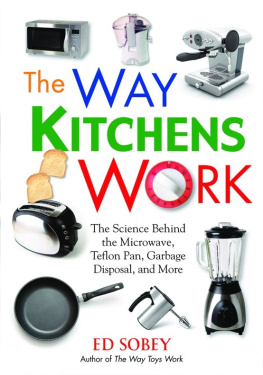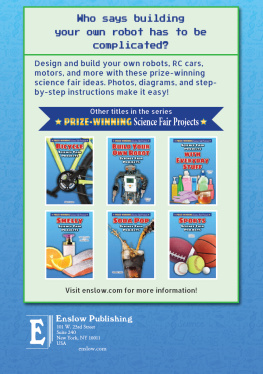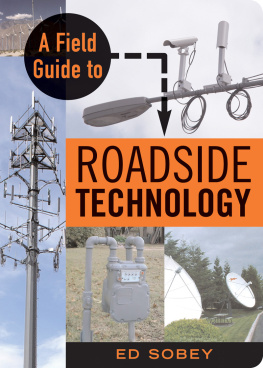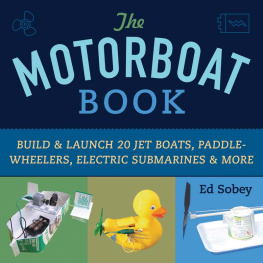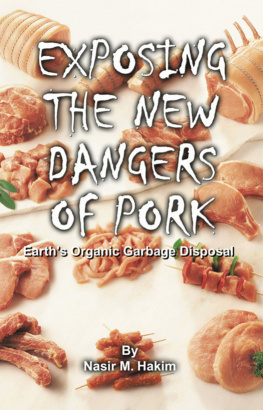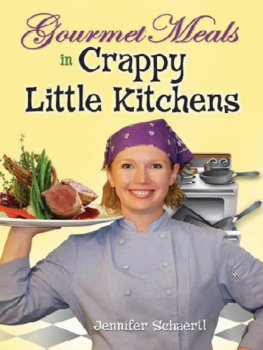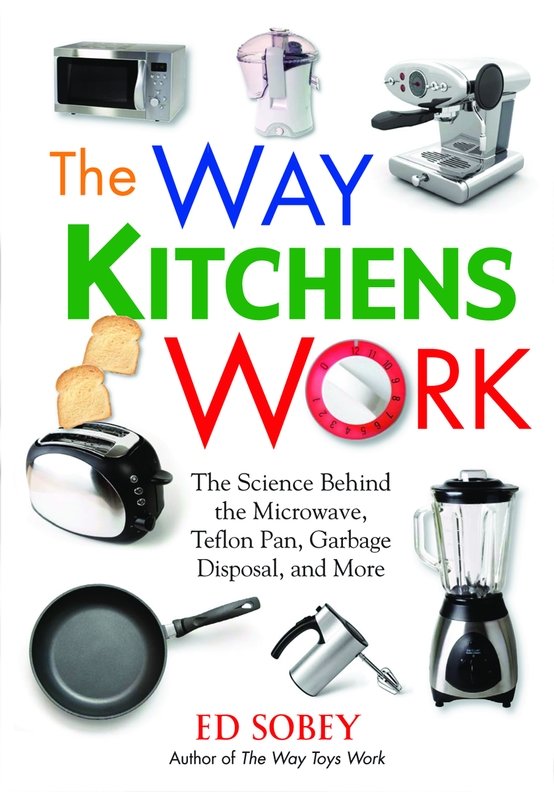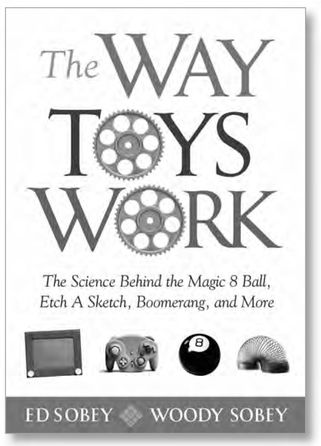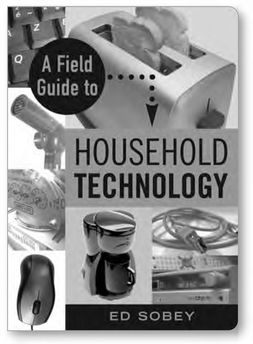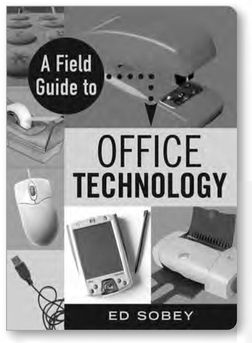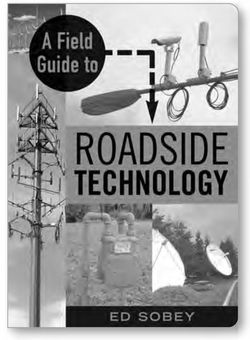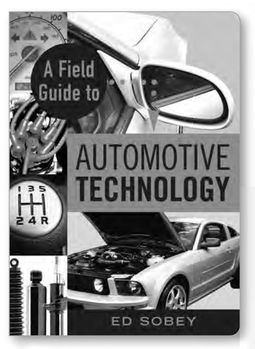ACKNOWLEDGMENTS
L ike several of my other books, The Way Kitchens Work benefits from photographs taken by Rich Sidwa. I have learned to ask for his help just after we finish a long run through the Watershed Nature Preserve, when he is feeling good but has weakened resistance.
Dave Wilson of Appliance Recycling Outlet in Snohomish, Washington, allowed me to take photos of appliances being repaired or recycled. He introduced me to Ron Gale, a wonderful guy from Forks, Washington, who took me on a tour of the recycling center and helped me take photographs of several kitchen devices. Ron grew up in the hardware and appliance business in Forks and was a fountain of knowledge for a science writer who had a lot to learn about major appliances.
Frank Slagle contributed his ancient toaster for me to take apart and photograph. They dont make them like thiseither Frank or his toasteranymore.
Metal Ware Corporation, manufacturers of Nesco products, sent the photo of their beautiful coffee roaster. The Fire House in Redmond, Washington, provided me with two fire extinguishers to take apart. Thanks, Christian.
Woody, my son and coauthor on The Way Toys Work , provided information about and photographs of homemade coffee roasters. Sue Maybee loaned her electric knife for a photo shoot.
Thank you all.
BIBLIOGRAPHY
Ehrlich, Robert. Turning the World Inside Out and 174 Other Simple Physics Demonstrations . Princeton, NJ: Princeton University Press, 1990.
Inventive Genius . Alexandria, VA: Time-Life Books, 1988.
The National Inventors Hall of Fame Black Book . 27th ed. Akron, OH: National Inventors Hall of Fame, 1999.
Panati, Charles. Extraordinary Origins of Everyday Things . New York: Harper Perennial, 1987.
Sobey, Ed. A Field Guide to Household Technology . Chicago: Chicago Review Press, 2007.
Sobey, Ed. A Field Guide to Office Technology . Chicago: Chicago Review Press, 2007.
Walker, Jearl. The Flying Circus of Physics . New York: Wiley, 1977.
ALSO FROM CHICAGO REVIEW PRESS
978-1-55652-745-6
$14.95 (CAN $16.95)
The Way Toys Work
The Science Behind the Magic 8 Ball, Etch A Sketch, Boomerang, and More Ed Sobey and Woody Sobey
A Selection of the Scientific American Book Club
This book is sure to provide hours of entertainment and enlightenment.
School Library Journal
How does an Etch A Sketch write on its gray screen; why does a boomerang return after it is thrown; and how does an R/C car respond to a radio-control device? Father/son author duo Ed and Woody Sobey explain the science hidden in these and dozens more of the worlds most popular toys. Each of the 50 entries includes the toys history, patent application drawings, interesting trivia, and a discussion of the technology involved. The authors even include pointers on how to build your own using recycled materials and a little ingenuity, and tips on reverse engineering old toys to get a better look at their interior mechanics. Readers will also enjoy photos of the guts of the devices, including a filleted Big Mouth Billy Bass. The only thing you wont learn is how the Magic 8 Ball is able to predict the futuresome things are better left a mystery.
978-1-55652-670-1
$14.95 (CAN $18.95)
A Field Guide to Household Technology
Ed Sobey
Illustrating how a bathroom scale measures body weight and what the plasma is in a plasma-screen television, this fascinating handbook explains how everyday household devices operate. More than 180 different devices are covered, including gadgets unique to apartment buildings and houseboats. Devices are grouped according to their habitatsliving room, family room, den, bedroom, kitchen, bathroom, and basementwith detailed descriptions of what they do and how they work, and photographs for easy identification. Youll never look at that pile of remote controls on your coffee table the same way again.
978-1-55652-696-1
$14.95 (CAN $18.95)
A Field Guide to Office Technology
Ed Sobey
The modern office can be a confusing technological landscape. How does a motion detector spot intruders? What is a voltage surge, and why does a computer need to be protected from it? And why do telephone keypads have their 1s in their upper left corners, while calculator keypads have their 1s in their lower left corners? Entries for more than 160 devices tell you how they work, who invented them, and how their designs have changed over the years. No longer will you need the IT staff to explain that mysterious blinking box in the coat closet.
978-1-55652-609-1
$14.95 (CAN $20.95)
A Field Guide to Roadside Technology
Ed Sobey
Fun, informative, and easy to use.
School Library Journal
If youve surveyed the modern landscape, youve no doubt wondered what all those towers, utility poles, antennas, and other strange, unnatural devices actually do. In A Field Guide to Roadside Technology , more than 150 devices are grouped according to their habitatsalong highways and roads, near airports, on utility towers, and moreand each includes a clear photo to make recognition easy. Once the species is identified, the entry will tell you its behaviorwhat it doesand how it works, in detail.
978-1-55652-812-5
$14.95 (CAN $16.95)
A Field Guide to Automotive Technology
Ed Sobey
If you dont know your catalytic converter from your universal joint, A Field Guide to Automotive Technology is for you. How does an airbag know when to deploy? What is rack and pinion steering? And where exactly does a dipstick dip? More than 120 mechanical devices are explored in detail, including their invention, function, and technical peculiarities. Youll also find information about components found on buses, motorcycles, bicycles, and more. Even seasoned gearheads will learn from this guide as it traces the history and development of mechanisms they may take for granted.
978-1-55652-697-8
$16.95 (CAN $18.95)
Why Theres Antifreeze in Your Toothpaste
The Chemistry of Household Ingredients
Simon Quellen Field
If youre like most people, you find it hard enough to pronounce the ingredients found in most household products, much less understand why theyre there. No longerwith Why Theres Antifreeze in Your Toothpaste youll be able to distinguish between preservatives and sweeteners, buffers and emulsifiers, stabilizers and surfactants. Ingredients are grouped according to type, and each entry contains the substances structural formula, synonymous names, and a description of its common uses. This helpful guide can be used as a basic primer on commercial chemistry or as an indexed reference to specific compounds found on a product label. Never fear the grocery again.

